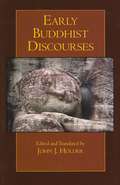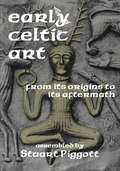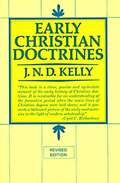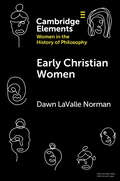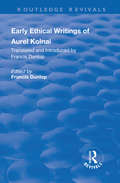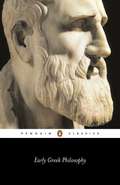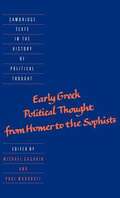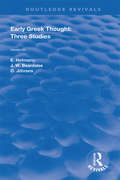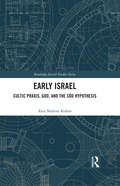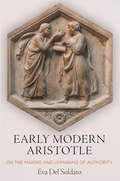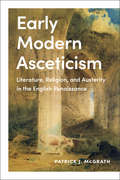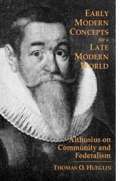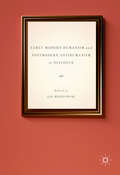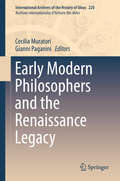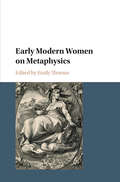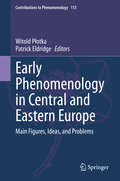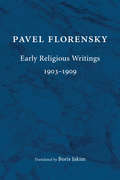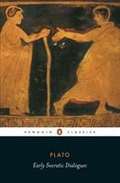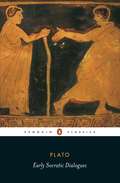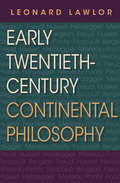- Table View
- List View
Early Buddhist Discourses
by John J. HolderTwenty discourses from the Pali Canon--including those most essential to the study and teaching of early Buddhism--are provided in fresh translations, accompanied by introductions that highlight the main themes and set the ideas presented in the context of wider philosophical and religious issues. Taken together, these fascinating works give an account of Buddhist teachings directly from the earliest primary sources.In his General Introduction, John J. Holder discusses the structure and language of the Pali Canon--its importance within the Buddhist tradition and the historical context in which it developed--and gives an overview of the basic doctrines of early Buddhism.
Early Buddhist Teachings
by Y. KarunadasaA clear, elegant clarification of the basic teachings of early Buddhism, ideal for both general readers and scholars. Discover the birth of Buddhism and the essentials of Buddhist teachings with this clear, comprehensive explanation of early Buddhism’s key doctrines. You’ll come away with: insight into the beginning of Buddhism and the significance of its core beliefs—dependent arising, non-self, moral life, the diagnosis of the human condition, the critique of theoretical views, and the nature of Nibbana; a lucid understanding of the Buddha’s challenge to the concept of the subject as a self-entity and the reality of both the subject and object, perceiver and perceived, as a dynamic process; a grasp of early Buddhist teachings as representing a middle position (equally aloof from spiritual eternalism and materialist annihilation) and a middle path (equally aloof from self-mortification and sensual indulgence); and the experience of the Buddha’s teachings on attaining liberation as comprehensible, sensible, and something we can make part of our own practice.
Early Celtic Art: From Its Origins to Its Aftermath
by Joel GibbonsFor many, perhaps most, the title Early Celtic Art summons up images of Early Christian stone crosses in Ireland, Scotland, Wales, or Cornwall; of Glendalough, lona or Tintagel; of the Ardagh Chalice or the Monymusk Reliquary; of the great illuminated gospels of Durrow or Lindisfame. But as Stuart Piggott notes, the consummate works of art produced under the aegis of the early churches in Britain or Ireland, in regions Celtic by tradition or language, have an ancestry behind them only partly Celtic.One strain in an eclectic style was borrowed from the ornament of the northern Germanic world, the classical Mediterranean, and even the Eastern churches. Early Celtic art, originating in the fifth century b.c. in Central Europe, was already seven or eight centuries old when it was last traced in the pagan, prehistoric world, and the transmission of some of its modes and motifs over a further span of centuries into the Christian Middle Ages was an even later phenomenon. This volume presents the art of the prehistoric Celtic peoples, the first great contribution of the barbarians to European arts.It is an art produced in circumstances that the classical world and contemporary societiesunhesitatingly recognize as uncivilized. Its appearance, it has been said by N. K. Sandars in Prehistoric Art in Europe: "is perhaps one of the oddest and most unlikely things to have come out of a barbarian continent. Its peculiar refinement, delicacy, and equilibrium are not altogether what one would expect of men who, though courageous and not without honor even in the records of their enemies, were also savage, cruel and often disgusting; for the archaeological refuse, as well as the reports of Classical antiquity, agree in this verdict."This book comprises the first major exhibition of Early Celtic Art from its origins and beginnings to its aftermath, and was assembled by Stuart Piggott who taught later European prehistory to Honors students in Archaeolog
Early Christian Doctrine
by J. N. D. KellyThis revised edition of the standard history of the first great period in Christian thought has been thoroughly updated in the light of the latest historical findings. Dr. Kelly organizes an ocean of material by outlining the development of each doctrine in its historical context. He lucidly summarizes the genesis of Chrisitian thought from the close of the apostolic age to the Council of Chalcedon in the fifth century--a time teeming with fresh and competing ideas. The doctrines of the Trinity, the authority of the Bible and tradition, the nature of Christ, salvation, original sin and grace, and the sacraments are all extensively treated in these pages. <p><p>This revised edition of Early Christian Doctrines includes: <p> <p>• Sweepingly updated early chapters <p>• Revised and updated bibliographies <p>• A completely new chapter on Mary and the saints
Early Christian Women (Elements on Women in the History of Philosophy)
by Dawn LaValle NormanIn this Element the author argues that genre deeply affects how early Christian female philosophers are characterized across different works. The included case studies are three women who feature in both narrative and dialogic texts: Thecla, Macrina the Younger and Monica. Based on these examples, the author demonstrates that the narrative sources tend to eschew secular education, while the dialogic sources are open to displays of secular knowledge. Philosophy was not only seen as a way of life, but sometimes also as a mode of educated argumentation. The author further argues that these female philosophers were held up in their femininity as models for imitation by both women and men.
Early Ethical Writings of Aurel Kolnai (Routledge Revivals)
by Francis DunlopThis title was first published in 2002: Kolnai's later work in moral philosophy is well-known, and interest in it continues to grow, but his dissertation, Ethical Value and Reality, has received little attention - although Kolnai himself said that it contains the germs of nearly all his subsequent thought. This first English translation of the dissertation and of two related papers from the same period will enable the English-speaking reader to explore Kolnai's ethical work as a whole. In Ethical Value and Reality Kolnai proposes a 'completion' of phenomenological value-ethics which takes account of 'the embeddedness of ethical values in reality'. Kolnai explores moral psychology and offers important perspectives on political activity in its moral dimensions, on the relation between morality and religion, and on the relation between the moral point of view and the psycho-therapeutic. Dunlop's comprehensive introduction to the translation provides the reader with assistance in understanding the text, setting it in its contemporary context, and relating it to Kolnai's subsequent writings.
Early Greek Philosophy (Penguin Classics)
by Jonathan BarnesThe works collected in this volume form the true foundation of Western philosophy - the base upon which Plato and Aristotle and their successors would eventually build. Yet the importance of the Pre-Socratics thinkers lies less in their influence - great though that was - than in their astonishing intellectual ambition and imaginative reach. Zeno's dizzying 'proofs' that motion is impossible; the extraordinary atomic theories of Democritus; the haunting and enigmatic epigrams of Heraclitus; and the maxims of Alcmaeon: fragmentary as they often are, the thoughts of these philosophers seem strikingly modern in their concern to forge a truly scientific vocabulary and way of reasoning.
Early Greek Political Thought from Homer to the Sophists
by Michael Gagarin Paul WoodruffThis edition of early Greek writings on social and political issues includes works by more than thirty authors, including the sophists, poets, tragedians, historians, medical writers and pre=Socratic philosophers. Besides political theory, ancient political thought includes early sociology, anthropology, ethics and rhetoric, and the wide range of issues discussed includes the origin of human society, the origin of law, the nature of justice, the forms of good government, and the distribution of power among genders and social classes.
Early Greek Thought: Three Studies (Routledge Revivals)
by E. Hofmann J. W. Beardslee O. JohrensOriginally compiled and published in 1922, this volume contains three studies on Early Greek Thought: E. Hofmann's Qua Ratione; J. W. Beardslee's Fifth-Century Greek Literature; and O. JOhrens's Die Fragmente des Anaxagoras.
Early Israel: Cultic Praxis, God, and the Sôd Hypothesis (Routledge Jewish Studies Series)
by Alex Shalom KohavEarly Israel offers the most sweeping reinterpretation of the Pentateuch since the nineteenth-century Documentary Hypothesis. Engaging a dozen-plus modern academic disciplines—from anthropology, biblical studies, Egyptology and semiotics, to linguistics, cognitive poetics and consciousness studies; from religious studies, Jewish studies, psychoanalysis and literary criticism, to mysticism studies, cognitive psychology, phenomenology and philosophy of mind—it wrests from the Pentateuch an outline of the heretofore undiscovered ancient Israelite mystical-initiatory tradition of the First Temple priests. The book effectively launches a new research area: Pentateuchal esoteric mysticism, akin to a "center" or "organizing principle" discussed in biblical theology. The recovered priestly system is discordant vis-à-vis the much-later rabbinical project. This volume appeals to a diverse academic community, from Biblical and Jewish studies to literary studies, religious studies, anthropology, and consciousness studies.
Early Medieval Philosophy 480-1150: An Introduction
by John MarenbonCompact but singularly well thought out material of a theological, logical, poetic as well as philosophical nature.
Early Modern Aristotle: On the Making and Unmaking of Authority
by Eva Del SoldatoA reassessment of how the legacy of ancient philosophy functioned in early modern EuropeIn his Nicomachean Ethics, Aristotle affirms that despite his friendship with Plato, he was a better friend of the truth. With this statement, he rejected his teacher's authority, implying that the pursuit of philosophy does not entail any such obedience. Yet over the centuries Aristotle himself became the authority par excellence in the Western world, and even notorious anti-Aristotelians such as Galileo Galilei preferred to keep him as a friend rather than to contradict him openly. In Early Modern Aristotle, Eva Del Soldato contends that because the authority of Aristotle—like that of any other ancient, including Plato—was a construct, it could be tailored and customized to serve agendas that were often in direct contrast to one another, at times even in open conflict with the very tenets of Peripatetic philosophy.Arguing that recourse to the principle of authority was not merely an instrument for inculcating minds with an immutable body of knowledge, Del Soldato investigates the ways in which the authority of Aristotle was exploited in a variety of contexts. The stories the five chapters tell often develop along the same chronological lines, and reveal consistent diachronic and synchronic patterns. Each focuses on strategies of negotiation, integration and rejection of Aristotle, considering both macro-phenomena, such as the philosophical genre of the comparatio (that is, a comparison of Aristotle and Plato's lives and doctrines), and smaller-scale receptions, such as the circulation of legends, anecdotes, fictions, and rhetorical tropes ("if Aristotle were alive . . ."), all featuring Aristotle as their protagonist. Through the analysis of surprisingly neglected episodes in intellectual history, Early Modern Aristotle traces how the authority of the ancient philosopher—constantly manipulated and negotiated—shaped philosophical and scientific debate in Europe from the fifteenth century until the dawn of the Enlightenment.
Early Modern Asceticism: Literature, Religion, and Austerity in the English Renaissance
by Patrick J. McGrathIn discussions of the works of Donne, Milton, Marvell, and Bunyan, Early Modern Asceticism shows how conflicting approaches to asceticism animate depictions of sexuality, subjectivity, and embodiment in early modern literature and religion. The book challenges the perception that the Renaissance marks a decisive shift in attitudes towards the body, sex, and the self. In early modernity, self-respect was a Satanic impulse that had to be annihilated – the body was not celebrated, but beaten into subjection – and, feeling circumscribed by sexual desire, ascetics found relief in pain, solitude, and deformity. On the basis of this austerity, Early Modern Asceticism questions the ease with which scholarship often elides the early and the modern.
Early Modern Concepts for a Late Modern World: Althusius on Community and Federalism
by Thomas O. HueglinJohannes Althusius (1557-1638) was a political theorist and a combative city politician who defended the rights of small communities against territorial absolutism. He designed a system of politics in which sovereignty would be shared and jointly exercised by a plurality of collectivities, spatial as well as social, on the basis of mutual consent and social solidarity. Early Modern Concepts for a Late Modern World places Althusius in the context of his times and explains the main features of his political thought. It also suggests, perhaps most significantly, why his theories continue to resonate today. Hueglin's use of sources is thorough and scrupulous. He has worked in depth in Germanic scholarship and this access to German-language sources, some of which are almost unknown to the English-speaking world, provides a new interpretation of Althusius' theory. With its emphasis on pluralized governance, negotiated compromise instead of majority rule, and the inclusion of the economic sphere into the political, Althusius' theory belongs to a countertradition in Western political thought. Although it was written at the beginning of the modern age of sovereign politics, it applies to today's search for a post-sovereign system of politics.
Early Modern Humanism and Postmodern Antihumanism in Dialogue
by Jan MiernowskiThis book employs perspectives from continental philosophy, intellectual history, and literary and cultural studies to breach the divide between early modernist and modernist thinkers. It turns to early modern humanism in order to challenge late 20th-century thought and present-day posthumanism. This book addresses contemporary concerns such as the moral responsibility of the artist, the place of religious beliefs in our secular societies, legal rights extended to nonhuman species, the sense of 'normality' applied to the human body, the politics of migration, individual political freedom and international terrorism. It demonstrates how early modern humanism can bring new perspectives to postmodern antihumanism and even invite us to envision a humanism of the future.
Early Modern Philosophers and the Renaissance Legacy
by Gianni Paganini Cecilia MuratoriThis book argues that an abrupt boundary should not divide Renaissance and Early Modern philosophies. Inside, 15 essays explore the transmission of theories through time. The contributors also examine how, in the process, philosophical systems become reinterpreted anew. Often, they acquire new shades of meaning and, even, become different ideas altogether. The essays discuss the question of whether Renaissance thinkers were philosophers in their own right or if they belonged to the history of literature and the arts. The authors also explore why scholars consider Renaissance thinkers separate from modern philosophers. In addition, the book details the legacy of Renaissance philosophers. It traces how later generations interacted with the texts these great minds left behind. Coverage includes the work of Henry More, Girolamo Cardano, Francis Bacon, Bernardino Telesio, René Descartes, Thomas Hobbes, and others. In recent years, a conception of a long Renaissance has emerged. This view extends the end point of the period to include the whole first half of the 17th century. Yet, this sense of continuity usually just stresses the modernity of Renaissance thinkers. This insightful volume presents a deeper portrait. It highlights the Renaissance legacy in early modern thought. In the process, readers will discover new interpretations to this period's great philosophical theories.
Early Modern Women on Metaphysics
by Emily ThomasThe work of women philosophers in the early modern period has traditionally been overlooked, yet their writing on topics such as reality, time, mind and matter holds valuable lessons for our understanding of metaphysics and its history. <P><P>This volume of new essays explores the work of nine key female figures: Bathsua Makin, Anna Maria van Schurman, Elisabeth of Bohemia, Margaret Cavendish, Anne Conway, Damaris Cudworth Masham, Mary Astell, Catharine Trotter Cockburn, and Émilie Du Châtelet. Investigating issues from eternity to free will and from body to natural laws, the essays uncover long-neglected perspectives and demonstrate their importance for philosophical debates, both then and now. <P>Combining careful philosophical analysis with discussion of the intellectual and historical context of each thinker, they will set the agenda for future enquiry and will appeal to scholars and students of the history of metaphysics, science, religion and feminism.<P> Brings to light new avenues of metaphysical enquiry based on the writing of previously neglected female philosophers.<P> Features detailed philosophical analysis as well as valuable historical and intellectual contexts.<P> Discusses many topics including free will, reality, gravity, time, matter, mind and body.
Early Phenomenology in Central and Eastern Europe: Main Figures, Ideas, and Problems (Contributions to Phenomenology #113)
by Patrick Eldridge Witold PłotkaThis book presents the origins of Central and Eastern European phenomenology. It features chapters that explore the movement's development, its most important thinkers, and its theoretical and historical context. This collection examines such topics as the realism-idealism controversy, the status of descriptive psychology, the question of the phenomenological method, and the problem of the world.The chapters span the first decades of the development of phenomenology in Czechoslovakia, Poland, Romania, Russia, and Yugoslavia before World War II. The contributors track the Brentanian heritage of the development. They show how this tradition inspired influential thinkers like Celms, Špet, Ingarden, Frank, Twardowski, Patočka, and others. The book also puts forward original investigations. Moreover it elaborates new accounts of the foundations of phenomenology. While the volume begins with the Brentanian heritage, it situates phenomenology in a dialogue with other important schools of thought of that time, including the Prague School and Lvov-Warsaw School of Logic.This collection highlights thinkers whose writings have had only a limited reception outside their home countries due to political and historical circumstances. It will help readers gain a better understanding of how the phenomenological movement developed beyond its start in Germany. Readers will also come to see how the phenomenological method resonated in different countries and led to new philosophical developments in ontology, epistemology, psychology, philosophy of culture, and philosophy of religion.
Early Postmodernism: Foundational Essays
by Paul A. BovéIn the decade that followed 1972, the journal boundary 2 consistently published many of the most distinguished and most influential statements of an emerging literary postmodernism. Recognizing postmodernism as a dominant force in culture, particularly in the literary and narrative imagination, the journal appeared when literary critical study in the United States was in a period of theory-induced ferment. The fundamental relations between postmodernism and poststructuralism were being initially examined and the effort to formulate a critical sense of the postmodern was underway. In this volume, Paul A. Bové, the current editor of boundary 2, has gathered many of those foundational essays and, as such, has assembled a basic text in the history of postmodernism.Essays by noted cultural and literary theorists join with Bové's contemporary preface to represent the important and unique moment in recent intellectual history when postmodernism was no longer seen primarily as an architectural term, had not yet come to describe the wide range of culture it does now, but was finding power and place in the literary realm. These essays show that the history of postmodernism and its attendant critical theories are both more complex and more deeply bound with literary criticism than often is acknowledged today. Early Postmodernism demonstrates not only the significance of these literary studies, but also the role played by literary critical postmodernism in making possible newer forms of critical and cultural studies.Contributors. Barry Alpert, Charles Altieri, David Antin, Harold Bloom, Paul A. Bové, Hélène Cixous, Gerald Gillespie, Ihab Hassan, Joseph N. Riddel, William, V. Spanos, Catharine R. Stimpson, Cornel West
Early Religious Writings, 1903-1909
by Pavel FlorenskyProfound writings by one of the twentieth century's greatest polymaths "Perhaps the most remarkable person devoured by the Gulag" is how Alexandr Solzhenitsyn described Pavel Florensky, a Russian Orthodox mathematician, scientist, linguist, art historian, philosopher, theologian, and priest who was martyred during the Bolshevik purges of the 1930s. This volume contains eight important religious works written by Florensky in the first decade of the twentieth century, now translated into English—most of them for the first time. Splendidly interweaving religious, scientific, and literary themes, these essays showcase the diversity of Florensky's broad learning and interests. Including reflections on the sacraments and explorations of Russian monastic culture, the volume concludes with "The Salt of the Earth," arguably Florensky's most spiritually moving work.
Early Religious Writings, 1903-1909
by Pavel FlorenskyProfound writings by one of the twentieth century's greatest polymaths "Perhaps the most remarkable person devoured by the Gulag" is how Alexandr Solzhenitsyn described Pavel Florensky, a Russian Orthodox mathematician, scientist, linguist, art historian, philosopher, theologian, and priest who was martyred during the Bolshevik purges of the 1930s. This volume contains eight important religious works written by Florensky in the first decade of the twentieth century, now translated into English—most of them for the first time. Splendidly interweaving religious, scientific, and literary themes, these essays showcase the diversity of Florensky's broad learning and interests. Including reflections on the sacraments and explorations of Russian monastic culture, the volume concludes with "The Salt of the Earth," arguably Florensky's most spiritually moving work.
Early Socratic Dialogues
by Plato Chris Emlyn-Jones Trevor J. SaundersRich in drama and humour, they include the controversial Ion, a debate on poetic inspiration; Laches, in which Socrates seeks to define bravery; and Euthydemus, which considers the relationship between philosophy and politics. Together, these dialogues provide a definitive portrait of the real Socrates and raise issues still keenly debated by philosophers, forming an incisive overview of Plato’s philosophy.
Early Socratic Dialogues
by Plato Emlyn-Jones ChrisRich in drama and humour, they include the controversial Ion, a debate on poetic inspiration; Laches, in which Socrates seeks to define bravery; and Euthydemus, which considers the relationship between philosophy and politics. Together, these dialogues provide a definitive portrait of the real Socrates and raise issues still keenly debated by philosophers, forming an incisive overview of Plato's philosophy.
Early Twentieth-Century Continental Philosophy (Studies in Continental Thought)
by Leonard Lawlor&“[A]n outstanding book that will serve as a fine supplement (and guide) to important primary texts in early twentieth-century continental philosophy&” (Notre Dame Philosophical Reviews). Early Twentieth-Century Continental Philosophy offers a lucid and engaging introduction to the major works of French and German philosophy in the first half of the century. Leonard Lawlor takes as his starting point the original publication of Bergson&’s Introduction to Metaphysics in 1903, and his endpoint as the original publication Foucault&’s The Thought of the Outside in 1966. Lawlor interprets key texts by major figures in the continental tradition, such as Bergson and Foucault, as well as Freud, Heidegger, Husserl, and Merleau-Ponty. Taken together, his assessment of these figures illustrates the major theoretical trends of the time―immanence, difference, multiplicity, and the overcoming of metaphysics.
Early Urban Planning V 1
by Richard LeGatesFirst published in 2004. This collection brings together five volumes of classic texts of early modern urban planning. These writings stem from the late nineteenth century up to World War II and permits the reader to evaluate the history of urban planning as one of the great characteristics of modernism and lays the groundwork for speculation about the future of urban planning in the fast-emerging new world. Volume 1 includes selected essays.
